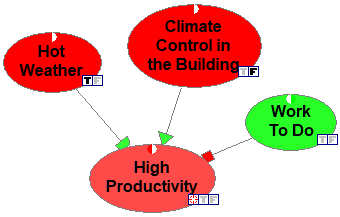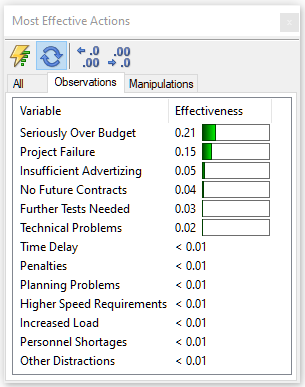Bayesian networks (also called belief networks, Bayesian belief networks, Bayes nets, causal probabilistic networks, or causal networks) (Pearl 1988) are acyclic directed graphs in which nodes represent random variables and arcs represent direct probabilistic dependences among them. The structure of a Bayesian network is a graphical, qualitative illustration of the interactions among the set of variables that it models. The structure of the directed graph can mimic the causal structure of the modeled domain, although this is not necessary. When the structure is causal, it gives a useful, modular insight into the interactions among the variables and allows for prediction of effects of external intervention.
The name Bayesian originates from the fact that the joint probability distribution represented by a Bayesian network is subjective (please recall that they are sometimes called belief networks; Bayesian approach is often used as a synonym for subjective view on probability) and this subjective probability distribution can be updated in the light of new evidence using Bayes theorem.
The purely theoretical view that the structure of a Bayesian network represents independences and that lack of an arc between any two variables X and Y represents a (possibly conditional) independence between them, is not intuitive and convenient in practice. A popular, slightly informal view of Bayesian networks is that they represent causal graphs in which every arc represents a direct causal influence between the variables that it connects. A directed arc from X to Y captures the knowledge that X is a causal factor for Y. While this view is informal and it is easy to construct mathematically correct counter-examples, it is convenient and widely used by almost everybody applying Bayesian networks in practice. There is a well-established assumption, with no convincing counter-examples, that causal graphs will automatically lead to correct patterns of independences. Lack of arcs between pairs of variables expresses simple facts about absence of causal influences between them. Independences between these pairs of variables follow from the structure of the graph. It is, thus, possible to construct Bayesian networks based purely on our understanding of causal relations between variables in our model.
Both, the structure and the numerical parameters of a Bayesian network, can be elicited from an expert. They can also be learned from data, as the structure of a Bayesian network is simply a representation of independences in the data and the numbers are a representation of the joint probability distributions, which can be inferred from the data. Finally, both the structure and the numerical probabilities can be based on a mixture of expert knowledge, measurements, and objective frequency data.
Structural properties of Bayesian networks, along with their numerical parameters allow for probabilistic reasoning within the model. Probabilistic reasoning within a BN is induced by observing evidence. A node that has been observed is called an evidence node. Observed nodes become instantiated, which means, in the simplest case, that their outcome is known with certainty. The impact of the evidence can be propagated through the network, modifying the probability distribution of other nodes that are probabilistically related to the evidence. For example, the network constructed in section Hello QGeNIe! allows for calculating the probability of high productivity (shown by color) given observations of hot weather and broken climate control device.

This calculation amounts at the foundations to a repetitive application of Bayes theorem in order to update the probability distributions of all nodes in the network. Different ways of applying Bayes theorem and different order of updating lead to different algorithms. Essentially, the existing algorithms for reasoning in Bayesian networks can be divided into three groups: message passing, graph reduction, and stochastic simulation. Explicit representation of independences allows for an increased computational tractability of probabilistic reasoning. Probabilistic inference in singly connected BNs is very efficient. Unfortunately, exact algorithms for multiply connected networks are liable to exponential complexity in the number of nodes in the network. Cooper (1990) has shown that the problem is NP-hard in general. Still, efficient software, like SMILE that is embedded into QGeNIe, offers reasonable computing times even in networks consisting of thousands of nodes.
The following network (Project) models various considerations faced by an airplane manufacturer

Observed Increased Load, Higher Speed Requirements, and Personnel Shortages lead to light green Negative Profit. A Bayesian network model allows for calculating the most informative future observations and actions. The following graph shows the most informative observations for the model and the situation pictured above.
